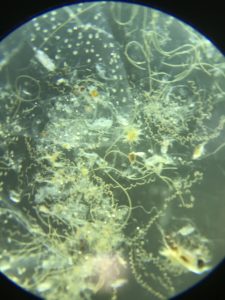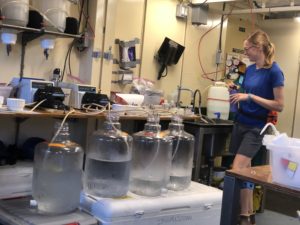
A tremendous quantity of animals, particles (dead and alive), and chemicals occupy the open ocean. Even in the nutrient-deplete, oligotrophic waters of the North Pacific Subtropical Gyre.
Animals and filamentous cyanobacteria
A small zooplankton net was the first package we deployed upon arrival to station ALOHA at 00:00 this morning. Angel White’s dreamy photo shows many different (relatively larger) ocean occupants gathered in this tow, including the seasonally abundant nitrogen-fixing filamentous cyanobacteria Trichodesmium.
Particles: sinking and suspended
For geochemists there are 2 types of particles, sinking (dead) and suspended (alive). These particles are usually the main food source for zooplankton. Suspended particles consist of phytoplankton cells, heterotrophic protists, and bacteria that are actively growing. While sinking particles tend to be larger, heavier aggregates of partly consumed plankton, fecal pellets, and amorphous organic matter. To capture these different types of particles we use different sampling devices: sediment traps are used to collect the sinking material and the CTD rosette or in situ pumps are used to collect the suspended material.
Under a full moon, our first free-floating sediment trap array was deployed at 02:50 by BB. Cael, Erin Black, Bethanie Edwards, and Tara Clemente.
12 trap tubes filled with brine and fixative were supported by cross-arms mounted at three depths (300, 150, 75m). At the surface of the array a beacon was attached so we can retrieve the trap. Using the ship’s ADCP (http://currents.soest.hawaii.edu/hot/) to observe water column currents, Matt Church and Tara Clemente decided to deploy the sediment traps just north (22°51.9810N 158°03.7939W) of ALOHA’s 6 mile radius circle (http://aco-ssds.soest.hawaii.edu/ALOHA/). Over the next 3 days the sediment trap array will drift through (and likely beyond) station ALOHA.
To collect suspended particles, many cruise participants are content using water from the CTD rosette Niskin bottles. The rosette holds 24 bottles with 12L capacity, so many different depths can be sampled. Or if you want, just 1-2 depths, but then you have a lot of water to put into carboys and carry around to the lab to filter. Here is a photo I took of Katherine Heal in the Hydro lab helping Wei Qin filter water from 1000m and 770m, only a few of the carboys are shown.

Other participants need more than 288L in order to measure trace metals, compound-specific isotopes, enzymes, and DNA. For this we use McLane pumps that can be deployed to a specific depth, and using battery power pump 1,920L filter over a 4-hour deployment. For these deployments we add a pre-filter to keep the sinking material separate from the in situ, actively growing organisms. Our first McLane pump deployment will be tonight, right after dinner.
